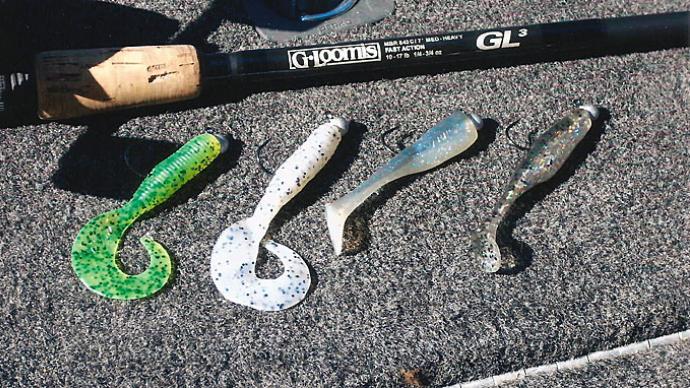Grubs are tiny lures that can catch big fish, especially big smallmouth bass, but experienced anglers are finding they work just as well on largemouths. They are especially well suited to highland reservoirs lacking extensive cover, where lures with more attention-getting qualities might be ignored by bass.
Grubs are essentially barjig heads with a soft-plastic body added to the hook. They are best suited for clear water situations. They are most often used as a deep-water lure but can be fished effectively in shallow water as well.
Grub Weight and Length
In general, the clearer the water and spookier the fish, the lighter the lead head and smaller the grub body you should use. Wind and depth will determine the lead head weight you should use with your grub. Use the lightest grub you can get away with in deep water because fish tend to hit them while falling, not when they are on the bottom. A light grub will take longer to fall and will be exposed to the fish longer. Smallmouth bass prefer shorter grubs, while largemouths can be taken on larger ones. Use 1/16 to 1/8 ounce grub head (a ball head - don't use slider heads) jigs for 3" grubs and 3/16 to 1/4 ounce jig heads for 5" grubs. Use spinning gear with a 6 to 6 1/2 foot medium-light to medium action rod and 8-10 pound test line.
Colors
Bass fishermen tend to prefer lighter colors on grubs. White, yellow, chartreuse, "motor oil", pumpkinseed, salt & pepper, and smoke are especially effective. Translucent grubs often have colored flecks or "metal flakes" mixed in. This helps reflect light and can increase your catch. In tough conditions, match grub color to water color. In greenish, clear water, try a green grub.
Fishing Techniques
| Drop it: | Fish the grub on a semi-slack line in deep, clear water. Hop it back to the boat. Always check the feel of the bait for anything different before the next hop. |
| Swim it: | Cast the grub, let it sink to the bottom, and immediately begin a slow, steady retrieve back to the boat. A twist-tail grub works well here. |
| Dart it: | Fan-cast the grub on a long point or flat. Let the lure sink a few feet, then jerk the rod tip to cause the lure to dart rapidly. Repeat the action all the way back to the boat. |
Tips
- In windy conditions, point the nose of the boat into the wind, cast toward the back of the boat, and use a slow, steady retrieve. The wave action will control the grub's movement.
- When fishing with heavy line, choose a grub with a strong, sharp hook. Avoid fine-wire hooks that can be easily straightened by a big bass. Use thin-wire hooks on light line because they penetrate better on softer hook sets.
- In the summer, when bass are hitting crankbaits in the morning and then stop, switch to a grub.
- Concentrate on what the bait is doing. It's hard to tell the difference between grass or moss and a bite. Rocks, wood and solid objects are easier to feel.
- The easiest way to get hung up is to pull hard when you're working through cover such as fallen trees. Jiggle the lure through instead.
- Use Kalin's 3-inch Salty Lunker grubs in rivers and streams to catch big smallmouth. Fish them in weeds and rocks. In weeds, cast your grub into the weedbed and drag it back to the weed edge. Then dart the grub back to you. The strike usually occurs in or at the weed edge. In rocks, fish the grubs with a darter head and fish the bait all the way back This is deadly on those big river smallies. You can also use a slow steady retrieve.




